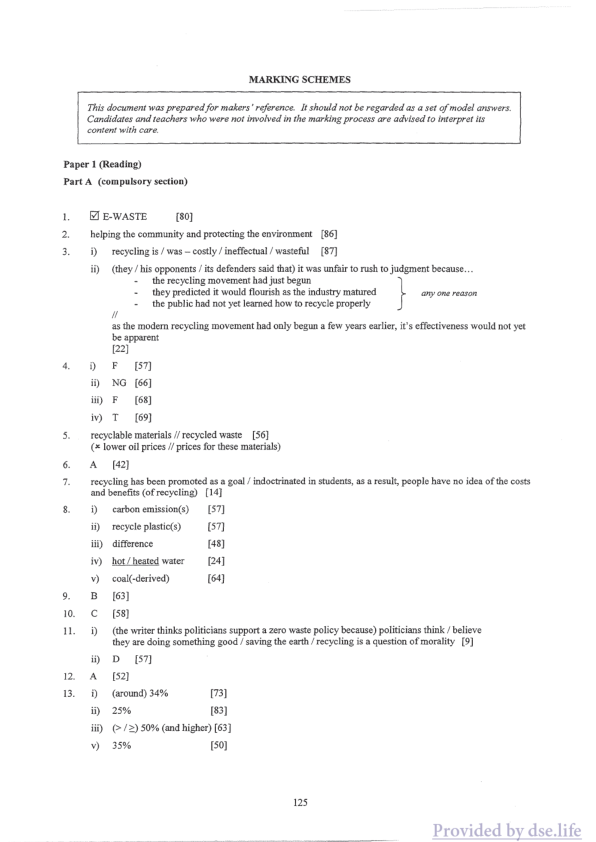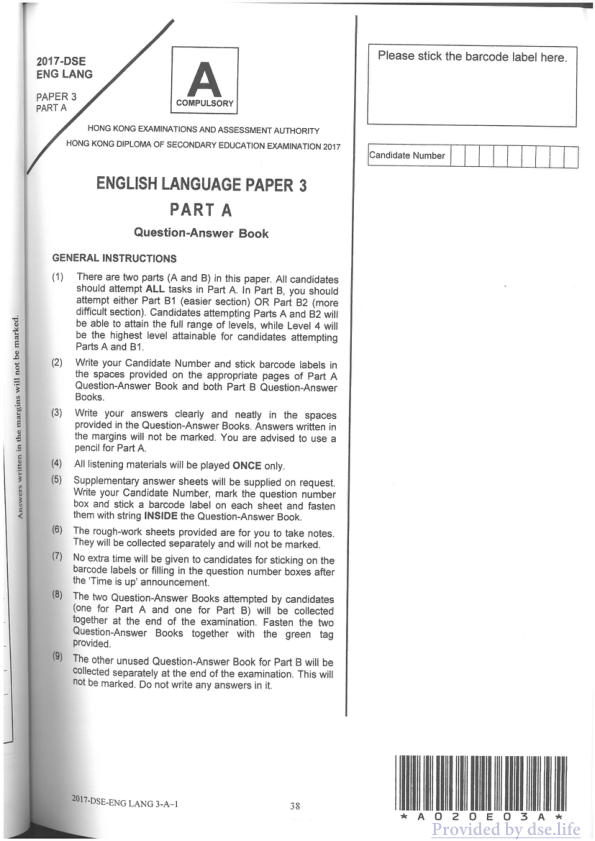2017 DSE 英国语文-English 真题 答案 详解
2017-05-01 dse dse 英国语文-English
| 序号 | 文件列表 | 说明 | ||
|---|---|---|---|---|
| 1 | 2017-英国语文-English-answer.pdf | 29 页 | 3.41MB | 答案 |
| 2 | 2017-英国语文-English-paper1.pdf | 24 页 | 12.77MB | 真题 Paper 1 |
| 3 | 2017-英国语文-English-paper2.pdf | 12 页 | 5.07MB | 真题 Paper 2 |
| 4 | 2017-英国语文-English-paper3.pdf | 39 页 | 14.74MB | 真题 Paper 3 |
| 5 | 2017-英国语文-English-paper4.pdf | 24 页 | 3.46MB | 真题 Paper 4 |
答案
MARKING SCHEMES
This document was prepared for makers' reference. It should not be regarded as a set of model answers. Candidates and teachers who were not involved in the marking process are advised to interpret its content with care.
Paper 1 (Reading) Part A (compulsory section)
- E-WASTE [80]
- helping the community and protecting the environment [86]
- i) recycling is / was – costly / ineffective / wasteful [87] ii) (they / his opponents / its defenders said that) it was unfair to rush to judgment because... - the recycling movement had just begun - they predicted it would flourish as the industry matured - the public had not yet learned how to recycle properly // as the modern recycling movement had only begun a few years earlier, it's effectiveness would not yet be apparent [22]
- i) F [57] ii) NG [66] iii) F [68] iv) T [69]
- recyclable materials // recycled waste [56] (* lower oil prices // prices for these materials)
- A [42]
- recycling has been promoted as a goal / indoctrinated in students, as a result, people have no idea of the costs and benefits (of recycling) [14]
- i) carbon emission(s) [57] ii) recycle plastic(s) [57] iii) difference [48] iv) hot / heated water [24] v) coal(-derived) [64]
- B [63]
- C [58]
- i) (the writer thinks politicians support a zero waste policy because) politicians think / believe they are doing something good / saving the earth / recycling is a question of morality [9] ii) D [57]
- A [52]
- i) (around) 34% [73] ii) 25% [83] iii) (> / ≥) 50% (and higher) [63] iv) 35% [50]
125 Provided by dse.life

真题 Paper 1
2017-DSE ENG LANG PAPER 1 PART A
HONG KONG EXAMINATIONS AND ASSESSMENT AUTHORITY HONG KONG DIPLOMA OF SECONDARY EDUCATION EXAMINATION 2017
ENGLISH LANGUAGE PAPER 1 PART A Reading Passages 8:30 am - 10:00 am (1½ hours) (for both Parts A and B)
GENERAL INSTRUCTIONS
(1) There are two parts (A and B) in this paper. All candidates should attempt Part A. In Part B, you should attempt either Part B1 (easier section) OR Part B2 (more difficult section). Candidates attempting Parts A and B2 will be able to attain the full range of levels, while Level 4 will be the highest level attainable for candidates attempting Parts A and B1.
(2) After the announcement of the start of the examination, you should first write your Candidate Number and stick barcode labels in the spaces provided on the appropriate pages of the Part A Question-Answer Book and the Part B Question-Answer Book which you are going to attempt.
(3) Write your answers in the spaces provided in the Question-Answer Books. Answers written in the margins will not be marked.
(4) For multiple-choice questions, you are advised to blacken the appropriate circle with a pencil so that wrong marks can be completely erased with a clean rubber. Mark only ONE answer to each question. Two or more answers will score NO MARKS.
(5) Supplementary answer sheets will be supplied on request. Write your Candidate Number, mark the question number box and stick a barcode label on each sheet and fasten them with string INSIDE the Question-Answer Book.
(6) No extra time will be given to candidates for sticking on barcode labels or filling in the question number boxes after the 'Time is up' announcement.
(7) The two Question-Answer Books you have attempted (one for Part A and one for Part B) will be collected together at the end of the examination. Fasten the two Question-Answer Books together with the green tag provided.
(8) The unused Question-Answer Book for Part B will be collected separately at the end of the examination. This will not be marked. Do not write any answers in it.
INSTRUCTIONS FOR PART A
(1) The Question-Answer Book for Part A is inserted in this Reading Passages booklet.
(2) Attempt ALL questions in Part A. Each question carries ONE mark unless otherwise stated.
© 香港考試及評核局保留版權 Hong Kong Examinations and Assessment Authority All Rights Reserved 2017
2017-DSE-ENG LANG 1-A-RP-I
Not to be taken away before the end of the examination session
Provided by dse.life

真题 Paper 2
2017-DSE ENG LANG PAPER 2
HONG KONG EXAMINATIONS AND ASSESSMENT AUTHORITY HONG KONG DIPLOMA OF SECONDARY EDUCATION EXAMINATION 2017
ENGLISH LANGUAGE PAPER 2 Question-Answer Book
11:00 am - 1:00 pm (2 hours) (for both Parts A and B)
INSTRUCTIONS
-
There are two parts (A and B) in this paper. Candidates should attempt Part A and ONE question from Part B.
-
After the announcement of the start of the examination, you should first write your Candidate Number in the space provided on Page 1 and stick barcode labels in the spaces provided on Pages 1, 3 and 5.
-
For Part B, you should put an 'X' in the corresponding question number box on Page 9 to indicate the question you are going to attempt.
-
Write your answers in the space provided in this Question-Answer Book. Answers written in the margins will not be marked.
-
Do not use your real name in answering any of the questions. If names are provided in the question, you must use those names. If no name is provided and you still wish to use a name to identify yourself, then use 'Chris Wong'. If you need to use names for other characters in the composition not specified by the question, you may use names such as Mary, Peter, Mr Smith, Ms Young, etc. You may lose marks if you do not follow these instructions.
-
Rough work should be done on the rough-work sheets which will be collected separately. These will not be marked.
-
Supplementary answer sheets will be supplied on request. Write your Candidate Number, mark the question number box and stick a barcode label on each sheet and fasten them with string INSIDE this book.
-
No extra time will be given to candidates for sticking on the barcode labels or filling in the question number boxes after the ‘Time is up’ announcement.
© 香港考試及評核局保留版權 Hong Kong Examinations and Assessment Authority All Rights Reserved 2017
2017-DSE-ENG LANG 2-1
AO20E002
Provided by dse.life

真题 Paper 3
2017-DSE ENG LANG PAPER 3 PART A
A COMPULSORY
HONG KONG EXAMINATIONS AND ASSESSMENT AUTHORITY HONG KONG DIPLOMA OF SECONDARY EDUCATION EXAMINATION 2017
ENGLISH LANGUAGE PAPER 3 PART A Question-Answer Book
GENERAL INSTRUCTIONS
(1) There are two parts (A and B) in this paper. All candidates should attempt ALL tasks in Part A. In Part B, you should attempt either Part B1 (easier section) OR Part B2 (more difficult section). Candidates attempting Parts A and B2 will be able to attain the full range of levels, while Level 4 will be the highest level attainable for candidates attempting Parts A and B1.
(2) Write your Candidate Number and stick barcode labels in the spaces provided on the appropriate pages of Part A Question-Answer Book and both Part B Question-Answer Books.
(3) Write your answers clearly and neatly in the spaces provided in the Question-Answer Books. Answers written in the margins will not be marked. You are advised to use a pencil for Part A.
(4) All listening materials will be played ONCE only.
(5) Supplementary answer sheets will be supplied on request. Write your Candidate Number, mark the question number box and stick a barcode label on each sheet and fasten them INSIDE the Question-Answer Book.
(6) The rough-work sheets provided are for you to take notes. They will be collected separately and will not be marked.
(7) No extra time will be given to candidates for sticking on the barcode labels or filling in the question number boxes after the 'Time is up' announcement.
(8) The two Question-Answer Books attempted by candidates (one for Part A and one for Part B) will be collected together at the end of the examination. Fasten the two Question-Answer Books together with the green tag provided.
(9) The other unused Question-Answer Book for Part B will be collected separately at the end of the examination. This will not be marked. Do not write any answers in it.
2017-DSE-ENG LANG 3-A-1 38
Please stick the barcode label here. Candidate Number
Answers written in the margins will not be marked.

真题 Paper 4
2017-DSE ENG LANG PAPER 4 EXAMINER 1.1 HONG KONG EXAMINATIONS AND ASSESSMENT AUTHORITY HONG KONG DIPLOMA OF SECONDARY EDUCATION EXAMINATION 2017 ENGLISH LANGUAGE PAPER 4 PART A Group Interaction This article appeared in a newspaper in Hong Kong: Young Hongkongers head north to Shenzhen for job opportunities Can't find your dream job in Hong Kong? Shenzhen's Qianhai economic zone may be the solution but you'd better be prepared to live without Facebook or Twitter. Herman Leung Ka-hin, who is from Hong Kong, is now working for a finance company in Shenzhen. Leung graduated this year and made the decision to work on the Mainland during his final year of study. “I believe in the prospect of mainland China economic growth,” he said. “It would be better for me to start my career in the Mainland.” Unlike jobs in Hong Kong with well-established career paths, Leung said his boss told him to expect uncertainty in his job because there were new policies and new developments all the time. Leung said that would give him more opportunities to try something new. “Before I came here, I worried about working with mainland colleagues as there might be cultural differences,” he said. “But after working here, I found that I had been over-worrying and I work with my mainland colleagues well.” Leung said pay levels in Qianhai were similar to Hong Kong but the cost of living was much lower. One thing he would like to see improve is the traffic. He lives in an apartment in northern Shenzhen provided by his employer and has to spend more than an hour travelling to or from Qianhai due to traffic jams. Hongkongers working in Qianhai also miss out on some popular social media networks such as Facebook and Twitter, which are banned on the Mainland along with some overseas websites. Your group has been asked to discuss whether Hongkongers could benefit from working in Shenzhen. You may want to talk about: advantages and disadvantages of working in Shenzhen whether this will become a popular trend advice for people who would like to work in Shenzhen anything else you think is important PART B Individual Response 1. Have you ever been to Shenzhen? 2. Would you like to work in Shenzhen? 3. Would you like to live outside Hong Kong? 4. What would you miss if you left Hong Kong? 5. What would be the best thing about working in Shenzhen? 6. What would you find difficult about working in mainland China? 7. Is it more common for Hongkongers to work outside Hong Kong than in the past? 8. Does Hong Kong lose or benefit from young people working in Shenzhen? DO NOT TAKE AWAY 77 Provided by dse.life

